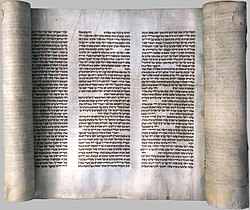Torah
Torah (Hebrew: תורה) is a Hebrew word that means "instructions". When most people say the word Torah they either mean the whole Jewish Bible (the Tanakh), the first five books of the Bible, or all of the Jewish teaching in general. These five books are the beginning of both the Jewish and Christian bibles. They are
- Genesis (Hebrew: Bereishit, בראשית),
- Exodus (Hebrew: Shemot, שמות),
- Leviticus (Hebrew: Vayikra, ויקרא),
- Numbers (Hebrew: Bemidbar, במדבר) and
- Deuteronomy (Hebrew: Devarim, דברים).
Other names for this set of books are the "Five Books of Moses," or "Pentateuch".
Each of the books in the Torah is separated into parts called "Parshiyot." Parsha is a Hebrew word meaning "portion." Every Shabbat one parsha is read in the synagogue, but sometimes two are read. This is so that all the parshiyot are finished every year, on the Jewish holiday of Simchat Torah.
It is also known as the Five Book of Moses because Moses received these five books from God.
The "Tawrat" (Arabic: توراة) is the Arabic name for the Torah within its context as an Islamic holy book believed by Muslims to be given by God (Allah) to prophets and messengers amongst the Children of Israel, and often refers to the entire Hebrew Bible.[1] It is mentioned many times in the Qur'an.
Pentateuch
Pentateuch means the first five books of the Bible. These books are Genesis, Exodus, Leviticus, Numbers, and Deuteronomy. The word Pentateuch comes from two Greek words that mean "five books" or "five scroll"
According to tradition, the books were written by the Israelite leader, Moses. The Pentateuch is often called the Five Books of Moses or the Torah.
The Pentateuch tells the story from the Creation of the world to the death of Moses and the preparation of the Israelite's to enter the land of Canaan. The story is told in three parts. The first part (Genesis 1-11) is about the Creation and the beginning of human beings on earth. The second part (Genesis 12-50) are the stories of the ancestors of the Israelites, mainly Abraham, Isaac, Jacob, and Joseph. The third part, beginning with the book of Exodus, describes how the Israelite's left Egypt and the early history of the people of Israel as a nation. It also has many laws about how the Israelite's must build their society. Deuteronomy is mostly Moses's final speech to his people and a summary of the Pentateuch.
Torah Media
An opened Torah scroll (Book of Genesis part).
Reading pointers, or yad, to ensure more ordinal reading of the Torah.
An opened Torah scroll (Book of Numbers part), and a reading pointer (yad).
The supplementary hypothesis, one potential successor to the documentary hypothesis.
Torahs in Ashkenazi Synagogue (Istanbul, Turkey).
Presentation of The Torah, by Édouard Moyse, 1860, Museum of Jewish Art and History.
Silver Torah case, Ottoman Empire, displayed in the Museum of Jewish Art and History.
Closeup of Torah scroll showing a verse from Numbers with tagin markings decorating letters written in Ktav Ashuri.
References
- ↑ Isabel Lang Intertextualität als hermeneutischer Zugang zur Auslegung des Korans: Eine Betrachtung am Beispiel der Verwendung von Israiliyyat in der Rezeption der Davidserzählung in Sure 38: 21-25 Logos Verlag Berlin GmbH, 31.12.2015 ISBN 9783832541514 p. 98 (German)
Other websites
- "The Torah". BBC. Retrieved 2011-09-19.
- "Torah Summary & Analysis".











